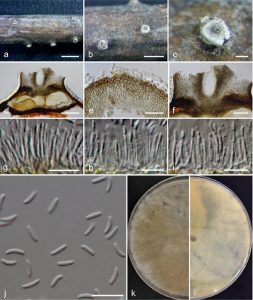Cytospora erumpens Norphanphoun, Bulgakov, T.C. Wen & K.D. Hyde, sp. nov., Index Fungorum number: IF552604
Etymology: The specific epithet ‘erumpens’ refers to the conidiomata characteristic as erumpent.
Holotype: MFLU 15-2165
Associated with twigs and branches of Salix × fragilis L. [S. alba L. × S. euxina I.V. Belyaeva]. Sexual morph: Undetermined. Asexual morph: Conidiomata 720–1000 × 470–550 μm diameter, semi-immersed in host tissue, solitary, erumpent, with 1–3 locules, with ostiolar neck. Ostioles 280–350 μm, at the same level as the disc surface. Peridium comprising a few to several layers of cells of textura angularis, with inner layer thin, pale brown, outer later brown to dark brown. Conidiophores unbranched or occasionally branched at the base, reduced to conidiogenous cells. Conidiogenous cells blastic, enteroblastic, phialidic, formed from the inner most layer of pycnidial wall, hyaline, smooth-walled. Conidia (5.6–)6.4–6.7 ×1.3–1.4(–1.7) μm (x̅ = 6.4 × 1.5 μm, n = 30), unicellular, elongate-allantoid, hyaline, thin-walled, smooth-walled.
Culture characteristics – Colonies on MEA, reaching 8.5 cm diameter after 7 days at 25 °C, producing dense mycelium, circular, margin rough, white, lacking aerial mycelium.
Material examined – RUSSIA, Rostov Region, Shakhty City, Grushevka steppe slopes, near Grushevsky pond, osier-bed near pond, on dead and dying branches of Salix × fragilis L. [S. alba L. × S. euxina I.V. Belyaeva]. (Salicaceae), 14 May 2015, T. Bulgakov, T-461 (MFLU 15-2165, holotype, PDD isotype), ex-type living culture, MFLUCC 16-0580, KUMCC.
Notes: Morphologically, Cytospora erumpens is most similar to C. sorbi (MFLUCC 16-0631) with conidia 6.4 × 1.5 μm versus 6.5 × 1.5 μm. However, in the combined gene phylogenetic analysis, C. erumpens is clearly separated from C. sorbi. Cytospora erumpens and C. rusanovii are similar in morphology and also associated with the same host, Salix spp. However, C. erumpens differs from C. rusanovii in forming black-discoid conidiomata on the host and longer ostiolar necks (C. erumpens: 280–350 μm versus 155–170 μm: C. rusanovii).
In phylogenetic study based on the ITS gene show that Cytospora erumpens is close to C. donetzica, but in the combined gene phylogenetic analysis, C. erumpens is separated from C. donetzica and some species in the genus (C. donetzica, C. sorbicola, C. sorbi, C. gigaspora, C. nivea, C. paratranslucens, C. translucens) with Bayesian posterior probabilities of 0.98 (Fig. 2). The ITS, RPB2 and ACT polymorphic nucleotides of sequence data, C. erumpens differs from C. sorbi with four ITS polymorphisms, 43 RPB2 polymorphisms and 13 ACT polymorphisms. Thus, it is considered that C. erumpens is a novel species.
FIG: Cytospora erumpens on Salix × fragilis L. (MFLU 15-2165, holotype). a Stromatal habit in wood. b Fruiting bodies on substrate. c Surface of fruiting bodies. d Cross section of the stroma showing conidiomata. e Peridium. f Ostiolar neck. g–i Conidiogenous cells with attached conidia. j Mature conidia. k, l Colonies on MEA (k-from above, l-from below). Scale bars: a = 2000 μm, b = 1000 μm, c, d = 200 μm, e = 50 μm, f = 100 μm, g–j = 10 μm.

